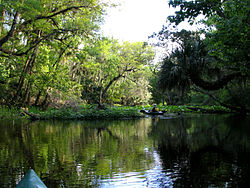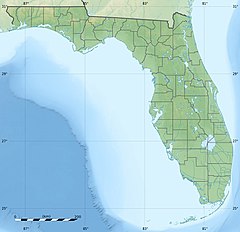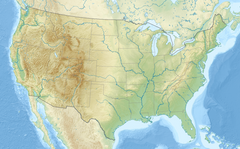| Wekiva River Wekiwa | |
|---|---|
 Canoeing on the Wekiva River | |
| Location | |
| Country | United States |
| State | Florida |
| Counties | Orange, Lake, Seminole |
| Physical characteristics | |
| Source | Wekiwa Springs |
| • location | Apopka, Florida |
| • coordinates | 28°42′42.80″N 81°27′37.5″W / 28.7118889°N 81.460417°W |
| • elevation | 70 ft (21 m) |
| Source confluence | Wekiwa Springs Run and Rock Springs Run |
| • location | Apopka, Florida |
| • coordinates | 28°42′54.5″N 81°26′57.2″W / 28.715139°N 81.449222°W |
| Mouth | |
• location | DeBary, Florida |
• coordinates | 28°52′39.2″N 81°22′1.3″W / 28.877556°N 81.367028°W |
• elevation | 30 ft (9.1 m) |
| Length | 16.0 mi (25.7 km) |
| Basin size | 351.113 sq mi (909.38 km2) |
| Basin features | |
| River system | St. Johns River |
| Tributaries | |
| • left | Rock Springs Run, Mastodon/Wekiva Falls Run, Blackwater Creek |
| • right | Sweetwater Creek, Little Wekiva River |
| Elevation reference | [1] |
| Progression : Wekiva River-St. Johns River-Atlantic Ocean | |
| Type | Wild, Scenic, Recreational |
| Designated | October 13, 2000 |
The Wekiva River (sometimes spelled Wekiwa, a Creek word meaning "spring of water"[2]) is a 16.0-mile-long (25.7 km) river in Central Florida, north of Orlando in the United States. It originates in Apopka and joins the St. Johns River, the longest river in the state, in DeBary. The Wekiva River system includes the main stem joined by three main tributaries - Rock Springs Run, Blackwater Creek, and the Little Wekiva River - and about 30 contributing groundwater springs.[3] It is designated as a Florida State Canoe Trail, an Outstanding Florida Water, and an Aquatic Preserve by the Florida Department of Environmental Protection.[4] The Wekiva River system is also one of the two rivers in Florida federally designated as a National Wild and Scenic River for its scenery, recreation, geology, and diverse habitats.[5]
Wekiwa is the Creek-Seminole word for a spring, but contrary to popular belief that Wekiva means "flowing water",[6] it was actually an alternate spelling used by developers.[7] The pronunciation of a soft-w, sometimes perceived as a v or b, resulted in cartographers mislabeling maps in later years. The maps drawn in 1838 and 1849 were spelled Wekiwa.[8]
- ^ "Wekiwa Springs State Park Topo Map". Trails.com. Retrieved on 2012-11-26.
- ^ Simpson, J. Clarence (1956). Mark F. Boyd (ed.). Florida Place-Names of Indian Derivation. Tallahassee, Florida: Florida Geological Survey.
- ^ "Wekiva River". St. Johns River Water Management District. Retrieved on 2013-04-02.
- ^ "Wekiva River Aquatic River Preserve". Florida Department of Environmental Protection. Retrieved on 2013-04-15.
- ^ "The Wekiva Wild & Scenic River". National Park Service. Retrieved on 2012-04-01.
- ^ Florida State Parks: Wekiwa Springs State Park: History and culture
- ^ Jim Toner, Orlando Sentinel, You Say 'Wekiva,' I Say 'Wekiwa', July 20, 1999
- ^ The Wekiwas and Wekivas of Orange County, Garner, Mary Kerns. 1983 December. Research sponsored by The Apopka Historical Society.


